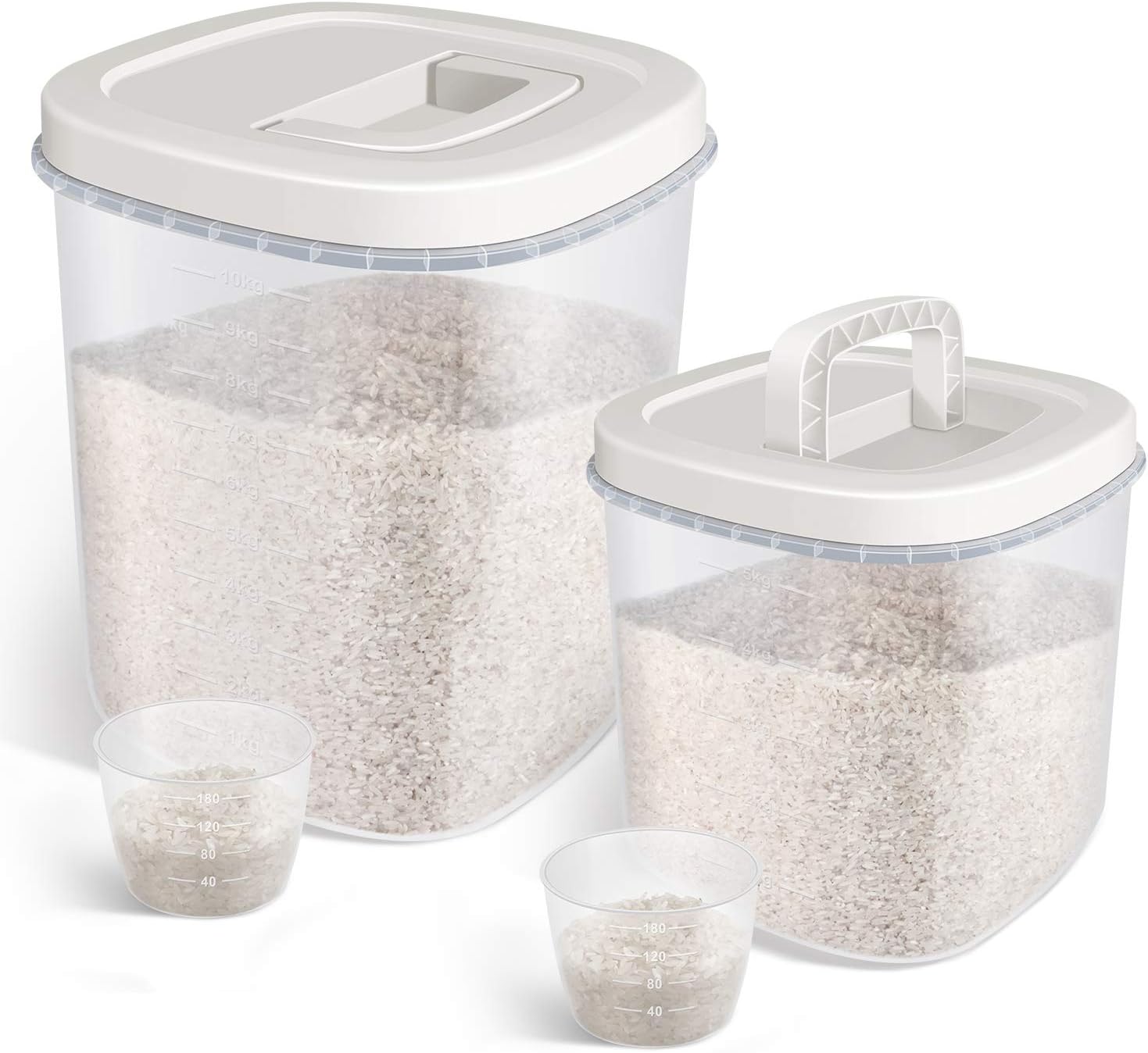

Articles
How To Store Rice Long-Term In Buckets
Modified: August 25, 2024
Learn how to store rice long-term in buckets with our expert articles. Get tips and tricks for preserving rice for extended periods.
(Many of the links in this article redirect to a specific reviewed product. Your purchase of these products through affiliate links helps to generate commission for Storables.com, at no extra cost. Learn more)
Introduction
Storing rice long-term in buckets is a great way to ensure you always have a reliable food source on hand. Whether you’re preparing for emergencies or simply looking to stock up on a staple food item, following the right steps to store rice properly is crucial to maintaining its quality and nutritional value.
In this article, we will guide you through the process of storing rice long-term in buckets. From choosing the right rice to sealing the buckets, we will cover all the necessary steps to ensure your rice stays fresh and safe for an extended period of time.
So, let’s dive into the world of rice storage and learn how to store rice in buckets like a pro.
Key Takeaways:
- Choose the right type of rice for long-term storage to ensure freshness and nutritional value. Opt for white rice with low oil content and consider varieties like basmati or jasmine rice for extended shelf life.
- Properly clean, portion, and seal rice in buckets with oxygen absorbers to maintain quality. Store in a cool, dry place, and regularly check and rotate stock for a reliable long-term food supply.
Read more: How To Store Flour Long Term In Buckets
Choosing the Right Rice
When it comes to storing rice long-term, selecting the right type of rice is crucial. Not all varieties of rice are suitable for long-term storage, as some have a higher oil content that can cause the rice to spoil more quickly.
For optimal long-term storage, it is recommended to choose white rice over brown rice. White rice has a longer shelf life due to its lower oil content and the removal of the bran and germ layers, which can cause the rice to spoil faster.
Additionally, look for rice varieties that are known for their long shelf life, such as basmati rice or jasmine rice. These varieties have a low moisture content and are less prone to spoilage. Avoid varieties like sticky rice or sushi rice, as they tend to have higher moisture content and can become sticky and clumpy after prolonged storage.
Consider purchasing rice that is specifically labeled for long-term storage. These rice varieties are often treated with additional processes that help to extend their shelf life and maintain their quality over time.
Lastly, buying rice in bulk is a more cost-effective option for long-term storage. Look for large bags or sacks of rice, as they are typically cheaper per pound compared to smaller retail packages.
By choosing the right type of rice for long-term storage, you can ensure that your stored rice will remain fresh and nutritious for an extended period of time.
Preparing the Buckets
Before you begin storing rice in buckets, it’s essential to make sure the buckets are clean and suitable for long-term food storage. Here are some steps to properly prepare your buckets:
- Choose food-grade buckets: Ensure that the buckets you use for storing rice are made of food-grade plastic. These buckets are specifically designed to be safe for storing food items and are usually labeled as such.
- Inspect the buckets: Before use, carefully inspect the buckets for any cracks, holes, or damage. It is essential to use buckets in good condition to maintain the integrity of your stored rice.
- Clean the buckets: Thoroughly clean the buckets with mild dish soap and warm water. Rinse them well to remove any soap residue.
After cleaning, you may also want to sanitize the buckets to eliminate any potential contaminants. You can do this by mixing a solution of one tablespoon of bleach per gallon of water and wiping down the inside of the buckets. Rinse them again thoroughly to remove any traces of bleach.
Let the buckets air dry completely before adding the rice. Moisture can promote the growth of mold or bacteria, so ensuring the buckets are dry is crucial for maintaining the quality of the stored rice.
By following these steps to prepare your buckets, you can create a clean and suitable environment for storing rice long-term.
Properly Cleaning the Rice
Before storing rice long-term, it’s important to properly clean the rice to remove any impurities or contaminants. Here’s a step-by-step guide on how to clean rice:
- Sort and remove debris: Spread the rice on a clean surface or a large tray and inspect it for any debris or foreign objects. Remove any stones, twigs, or other non-rice items you may come across.
- Rinse the rice: Place the rice in a fine mesh strainer or a colander and rinse it under cold running water. Gently swish the rice around with your fingers to ensure all the grains are thoroughly rinsed.
- Repeat the rinsing process: Repeat the rinsing process 2-3 times until the water runs clear. This helps to remove excess starch and impurities from the rice.
- Soak the rice (optional): Some people prefer to soak the rice before cooking to improve its texture and shorten the cooking time. If you prefer to soak the rice, place it in a bowl and cover it with water. Let it soak for 20-30 minutes, then drain the water.
- Drain the rice: After rinsing or soaking, drain the rice thoroughly to remove any excess water. Let it sit in the strainer or colander for a few minutes to ensure all the water is drained.
Properly cleaning the rice helps to remove dirt, dust, and other contaminants that may affect the quality of the stored rice. It also helps to prevent the rice from becoming sticky or clumpy when cooked.
Once the rice is cleaned and drained, it is ready to be portioned and stored in the buckets.
Measuring and Portioning the Rice
When it comes to storing rice long-term, it’s important to measure and portion the rice properly to ensure you have enough for your needs while minimizing the risk of waste. Here are some steps to follow:
- Calculate your needs: Determine how much rice you and your family consume on a regular basis. Take into consideration factors such as the number of meals per day and the portion size.
- Choose a measuring cup: Use a standard measuring cup to measure the rice. The most common size is 1 cup, but you can choose a larger size if you prefer.
- Portion the rice: Start by measuring the desired amount of rice for one serving. Then, multiply that amount by the number of servings you want to store. For example, if you want to store rice for a family of four for one month, and each person consumes 1/2 cup of rice per meal, you will need to portion and store 60 cups (4 people x 3 meals x 30 days x 1/2 cup).
- Use a scale (optional): If you prefer a more precise measurement, you can use a kitchen scale to weigh the rice. This can be especially helpful if you want to portion the rice based on weight rather than volume.
As you portion the rice, keep in mind the capacity of the buckets you are using for storage. It’s a good idea to leave some headspace in the buckets to allow for the addition of oxygen absorbers and proper sealing.
By measuring and portioning the rice accurately, you can ensure that you have enough rice for your needs and avoid unnecessary waste.
Add a few bay leaves to the rice before sealing the bucket to help repel insects and keep the rice fresh for longer.
Read more: How To Store Barley Long Term
Adding Oxygen Absorbers
When storing rice long-term, it’s important to minimize the presence of oxygen in the storage containers. Oxygen can contribute to the degradation of the rice by promoting oxidation, which can lead to a loss of quality and the growth of harmful microorganisms. This is where oxygen absorbers come into play.
Oxygen absorbers are small packets that contain iron powder. They are designed to absorb oxygen, creating a low-oxygen environment within the storage container. Here’s how to properly add oxygen absorbers when storing rice:
- Choose the right size: Ensure that the size of the oxygen absorbers matches the amount of rice you are storing. Oxygen absorbers are available in different sizes, typically measured by the amount of oxygen they can absorb.
- Count the packets: Refer to the instructions provided with the oxygen absorbers to determine the recommended number of packets per container. This is usually based on the volume or weight of the rice being stored.
- Place the packets: Open the package of oxygen absorbers just before use to prevent exposure to air. Place the recommended number of packets on top of the rice in each bucket.
- Seal the packets: Before sealing the buckets, ensure that the oxygen absorbers are properly sealed. Unused oxygen absorbers should be kept in airtight containers to maintain their effectiveness.
Once added to the buckets, the oxygen absorbers will start absorbing any remaining oxygen, creating a low-oxygen environment that helps to preserve the quality and freshness of the rice.
Note that once opened, oxygen absorbers start working immediately and have a limited effective lifespan. It’s important to use them promptly and seal any unused absorbers properly to maintain their efficacy.
By adding oxygen absorbers to your rice storage containers, you can significantly extend the shelf life of the rice and ensure its optimal quality in the long run.
Sealing the Buckets
After adding the rice and oxygen absorbers to the buckets, it’s crucial to properly seal them to create an airtight environment. Sealing the buckets effectively prevents the entry of moisture, pests, and contaminants, ensuring the long-term freshness and quality of the rice. Here’s how to seal the buckets:
- Ensure a clean rim: Wipe the rim of each bucket with a clean cloth or paper towel to remove any rice particles or debris. This helps to create a smooth and clean surface for proper sealing.
- Place a lid on the bucket: Position a food-grade lid on top of the bucket, ensuring it fits securely.
- Use a rubber mallet: Gently tap around the edges of the lid with a rubber mallet to create a tight seal. Start at one point and work your way around, applying gentle pressure as you go.
- Check for proper sealing: After sealing the buckets, ensure that they are tightly sealed and there are no gaps or openings. You can do this by pressing down on the lid to check for any movement or resistance.
It’s important to note that some buckets come with a built-in sealing mechanism, such as a gamma seal lid. These lids provide an airtight and easy-to-open seal that can be secured without the need for a mallet.
Once the buckets are properly sealed, label each bucket with the date of storage. This will help you keep track of the rice’s shelf life and ensure proper rotation when needed.
By effectively sealing the buckets, you can create a barrier that protects the rice from external elements and preserves its quality over an extended period of time.
Storing the Buckets in a Cool and Dry Place
Once the buckets of rice are properly sealed, it’s important to store them in a cool and dry place. The storage conditions play a vital role in maintaining the quality and freshness of the rice over time. Here are some key considerations for storing the buckets:
- Temperature: Aim to store the rice in an environment with a relatively stable and cool temperature. Ideally, the temperature should be below 70°F (21°C) to prevent the rice from spoiling or becoming rancid.
- Avoid sunlight exposure: Direct sunlight can cause the temperature inside the storage area to rise, potentially leading to spoilage. Therefore, choose a location away from windows or areas prone to direct sunlight.
- Humidity control: Rice should be stored in a low humidity environment to prevent the growth of mold or moisture absorption. Aim for a humidity level below 15% if possible.
- Avoid areas with strong odors: Rice can absorb odors easily, so avoid storing it in areas with strong odors or chemicals that could affect the flavor and quality of the rice.
- Elevate from the ground: Place the buckets on pallets or shelves to prevent direct contact with the floor. This helps to avoid moisture seepage and potential pest infestation.
It’s also important to periodically check the storage area for any signs of moisture, pests, or temperature fluctuations. Regular inspections can help you address any issues promptly and ensure the longevity of the stored rice.
By storing the buckets of rice in a cool and dry place, you will provide an optimal environment that helps to preserve the quality, flavor, and nutritional value of the rice for an extended period of time.
Checking and Rotating the Rice
When storing rice long-term, it is essential to periodically check and rotate the rice to maintain its quality and ensure that it remains fresh and safe to consume. Here are some important steps to follow when checking and rotating your stored rice:
- Regular inspections: Set a schedule to inspect the stored rice at least every six months or as recommended by the manufacturer. This allows you to identify any signs of spoilage, pests, or other issues that may compromise the quality of the rice.
- Inspect for signs of spoilage: During your inspections, check for any mold growth, unusual odors, or discoloration in the rice. These are indications that the stored rice has deteriorated and should not be consumed.
- Look for pest infestation: Examine the rice for any signs of pests such as insects or rodents. Pests can infiltrate storage areas and contaminate the rice, rendering it unsafe for consumption.
- Rotate the rice: To prevent the rice from sitting for too long, rotate your stock by using the older batches of rice first and replacing them with new ones. This helps to ensure that you are constantly consuming the oldest rice and maintaining a fresh supply.
- Properly reseal the buckets: After checking and rotating the rice, make sure to properly reseal the buckets to maintain their airtight seal and preserve the freshness of the contents.
Always remember to adhere to the recommended storage duration provided for the specific type of rice you are storing. Over time, even with proper storage, rice can lose its quality and nutritional value.
By regularly checking and rotating your stored rice, you can be confident that you’re consuming fresh and safe grains, while also preventing waste and ensuring that your food supply remains well-managed.
Read more: How To Store Fabric Long Term
Conclusion
Storing rice long-term in buckets is a practical and effective way to ensure a stable food supply. By following the proper steps, you can preserve the quality, flavor, and nutritional value of rice for an extended period of time.
Choosing the right type of rice, preparing the buckets, properly cleaning the rice, and measuring and portioning the rice are all essential steps in the storage process. Adding oxygen absorbers and sealing the buckets tightly create an ideal environment for long-term storage. Storing the buckets in a cool and dry place, while periodically checking and rotating the rice, ensures that it remains fresh and safe to consume.
Remember to always follow the guidelines provided by the manufacturers and consider the expiration date of the rice. Regularly inspecting your stored rice will help you identify any signs of spoilage, pests, or other issues that may affect its quality. By rotating your stock, you can ensure that you’re consistently consuming the oldest rice and maintaining a fresh supply.
With proper storage techniques, you can have peace of mind knowing that you have a reliable and nutritious food source available even during emergencies or uncertain times.
So, take the time to store your rice properly in buckets, and enjoy the convenience and reassurance of having a long-lasting food supply right at your fingertips.
Frequently Asked Questions about How To Store Rice Long-Term In Buckets
Was this page helpful?
At Storables.com, we guarantee accurate and reliable information. Our content, validated by Expert Board Contributors, is crafted following stringent Editorial Policies. We're committed to providing you with well-researched, expert-backed insights for all your informational needs.














0 thoughts on “How To Store Rice Long-Term In Buckets”